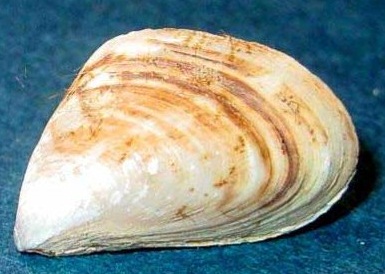Dreissena rostriformis bugensis
Quagga Mussel
Class: Bivalvia
Order: Veneroida
Family: Dreissenidae

Source: http://www.fs.usda.gov/Internet/FSE_MEDIA/stelprdb5302375.jpg
Description
Quagga mussels resemble zebra mussels, but are generally rounder in shape with shells that appear asymmetrical when viewed from the front. There are usually dark bands on the shell that fade near the hinge, but shell patterns are quite variable and the bands may be black, cream or white. This mussel attaches to hard surfaces with byssal threads and form mussel colonies and/or mats that are 4-12inches thick. Quagga mussels typically are the size of a thumbnail but shells can grow to lengths of about 1.5 inches.
Ecological Threat: The Quagga mussel can negatively impact native species by out-competing them for resources such as space and food. Through removing phytoplankton from the water column, Quagga mussels subsequently reduce food for zooplankton eaters, causing a trophic cascade. Additionally, increasing populations of Quagga mussels reduce the planktonic green algae needed for freshwater macro-invertebrates. The change in algae amounts causes water clarity and changes the species composition of the plant sources. Since floating plants become nursery areas for aquatic organisms a change in plant species can greatly affect the ecosystem. Also, much like the zebra mussel, Quagga mussels clog pipes and screen on intake structures, which reduces the pumping capacity and damages equipment and costs industries millions of dollars to fix. The fouling of structures has become a major problem along the Colorado River which supplied drinking and irrigation water through long aqueducts to major cities and farming regions of southern California, Nevada and Arizona.
Biology: Individuals are ether male or female and the reproduce externally when eggs and sperm are released into the water column. The larvae develop in a few days are soon tiny bivalve shells appear on the larvae as they drift with the plankton for 3-4 weeks. When appropriate substrates are found, juveniles settle and attach themselves with byssal threads. Adults are also sessile, but they can detach and settle in a new area. In the Great Lakes, spawning peaks in spring and autumn but at Lake Havasu on the Colorado River, they can spawn six times a year. The average lifespan is five years.
History: The Quagga mussel was first identified in the Great Lakes in 1989 presumbly from the Ukraine. The introduction of D. rostriformis bugensis into the Great Lakes appears to be the result of ballast water discharge from transoceanic ships that were carrying veligers, juveniles, or adult mussels. In January, 2007, the mussels showed up near Nevada along the Colorado River and are now present all throughout the region in California, Arizona, New Mexico and other river systems more eastward.
U.S. Habitat: Lakes, reservoirs and connecting waterways. They do best in freshwater with lower salinities but they can still reproduce in brackish water. The can colonize in hard or soft waters and can be found from the water surface to more than 400 feet deep.
Distribution
Native Origin: Eurasia
U.S. Present: AZ, CA, CO, KS, IL, IN, MI, NM, NV, NY, OH, PA, UT, WI
Management
A variety of control methods are available, but none so far have proven both effective and environmentally sound. Biological controls that would target the larval stages or interfere with their reproductive cycle are being looked into. What can be done on the local level is always clean your boat once you leave a body of water, drain the boat if needed and also inspect bodies of water for the presence of the mussels before launching.
The Aquatic Nuisance Species Task Force created a Action Plan for Quagga and Zebra mussels in Western U.S. waters. Click the link below for more information!
ANS Management Plan for Quagga and Zebra mussels.
Text References
District, M. W. 2007. Feared quagga mussel turns up in western United States. Science, 315:453-453.
Roe, S. L., & MacIsaac, H. J. 1997. Deepwater population structure and reproductive state of quagga mussels (Dreissena bugensis) in Lake Erie. Canadian Journal of Fisheries and Aquatic Sciences, 54(10):2428-2433.
Woodward, Susan L., and Joyce Ann. Quinn. 2011. Quagga Mussel. Encyclopedia of Invasive Species: From Africanized Honey Bees to Zebra Mussels. Santa Barbara, CA: Greenwood. 76-78. Print.
Internet Sources
http://www.dfw.state.or.us/conservationstrategy/invasive_species/zebra_quagga.asp
http://www.agri.state.id.us/Categories/Environment/InvasiveSpeciesCouncil/Quagga_Zebra_Mussels.php
http://nas.er.usgs.gov/queries/FactSheet.aspx?speciesID=95
http://www.invasivespeciesinfo.gov/aquatics/zebramussel.shtml
http://www.resources.ca.gov/quagga/docs/quagga_factsheet.pdf
 Texas Invasive Species Institute
Texas Invasive Species Institute